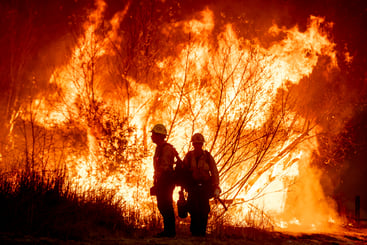Public-Private Partnerships: Unlocking the Potential For Tribal Communities
Public-Private Partnerships: Unlocking the Potential For Tribal Communities
This June marks the one-year anniversary of the passage of the historic Bipartisan Infrastructure Law, which invested substantial federal dollars in Tribal Nations, and it was followed by the Inflation Reduction Act, which passed a couple months later. Through these two laws, the federal government has dedicated funding directly to Tribes, providing nearly $14 billion for various projects, including critical infrastructure like roads and bridges, access to clean drinking water, and action on climate change and environmental justice; prioritizing Tribal communities who have often been left behind.
This is a good start, but philanthropy can help catalyze so much more good work that is already happening. If philanthropy follows the lead of the federal government and prioritizes investments in Tribal Nations and Indigenous-led organizations, particularly opportunities that support Tribes’ access to these new federal resources, the result could be transformational. Public-private partnerships are the framework we need to not only keep this momentum going, but accelerate long-term, sustainable Indigenous leadership and capacity. The framework isn’t new, but has been underutilized to support Tribal-led initiatives and causes. These partnerships, when done right, allow Tribes to lead and use their knowledge to collectively benefit our communities.
Coupled with the formation of the Office of Strategic Partnerships (OSP) within the Department of the Interior, the federal government is building bridges between government, philanthropy, and Tribal communities. OSP and the new federal spending bills offer long-term opportunities to develop public-private partnerships that support tribal economies, environmental stewardship, education, and more. These were big wins for funding for Tribal communities, but the work cannot end here. This is the moment for philanthropy to join in and invest in public-private partnerships.
The impact speaks for itself. For example, the America the Beautiful Challenge, made possible with new funding from the Inflation Reduction Act and Infrastructure law, recently awarded funds to the United Keetoowah Band of Cherokee in Oklahoma for river ecosystem restoration and promote connection to Keetoowah traditional practices, and the Igiugig Village Council received a grant to build up Indigenous-led environmental monitoring in Southwest Alaska. With funding from the Bipartisan Infrastructure Bill, the Indian Health Service within the U.S. Department of Health and Human Services allocated $700 million to Tribes for the improvement of water and sanitation systems. This funding, driven by demand from Tribal leaders, will have vast improvements on health outcomes for Tribes by increasing Indigenous access to safe water and wastewater disposal.
As part of the Bipartisan Infrastructure Law, the Confederated Tribes of the Warm Springs Reservation of Oregon received funding from the US Department of Agriculture to help with forest restoration. This put an explicit emphasis on Indigenous leadership for conservation, restoration, and co-stewardship of the environment to help fight the impacts of climate change. One lane of funding will help revive Tribal fire practices to address out-of-control fires and tap into traditional knowledge of forest management – supporting the growth and health of several keystone species and plants. Other funding priorities include Tribal-led initiatives protecting cultural resources, reducing hazardous fuels and promoting ecosystem and watershed health. But this $12 million, specifically for fulfillment of the Tribal Forest Protection Act (2004), will be allocated to over 30 Tribes. While this investment will have a marked impact on the environment in these areas—and cement the importance and expertise of Indigenous leadership—this funding will be spread thin.
The inclusion of extra funds from private organizations could boost the efficacy of programs like these from the Bipartisan Infrastructure Law, ensuring Tribal sovereignty and uplifting Indigenous leadership when it comes to protecting our planet. Many private organizations have already taken steps to encourage education for philanthropy on these opportunities and how to get involved. The Tribal Nations Conservation Pledge and Fund, borne from the collaboration of Native Americans in Philanthropy and Biodiversity Funders Group, is one example of an organization working to streamline philanthropic funding toward federal projects, educate funders, and remove barriers to funding for Tribal Nations like match guarantees.
Tribes have struggled with many forms of capacity and infrastructure for generations. We finally have potentially transformational federal investments on the table, but many tribal communities don’t have the capacity to access them. This is where philanthropy, government, and the Native-led nonprofits that support tribal governments and communities need to develop innovative partnerships like the Tribal Nations Conservation Pledge. By aligning tribal government and nonprofit leadership with the right resources, philanthropy has a massive opportunity to leverage their impact.
Funders need to be proactive and seek out education on how to utilize their resources to invest in Tribal community leadership and capacity already in place to support Tribal access to funds. We need new, innovative mechanisms for philanthropy to move funding that will align with community and federal priorities.
Investments from the federal government in Indigenous leadership, like the Bipartisan Infrastructure Law and the Inflation Reduction Act, can only be the beginning; we must utilize all the funding pathways we can, including public-private partnerships, to ensure this moment is impactful and lasting. More public-private partnerships will also lead to increased recognition of the positive effects of our Indigenous leadership—better education and child welfare practices, action on climate change and conservation, and economic benefits nationwide. Indigenous progress leads to progress nationwide, and there’s never been a better time for philanthropy to invest in Tribal communities and Indigenous knowledge for a brighter future.




Comments